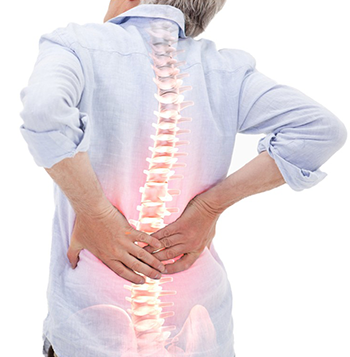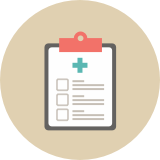SYMPTOMS AND CAUSES OF AS AND NR-AXSPA
Early symptoms of AS and nr-axSpA
The first symptoms of ankylosing spondylitis (AS) and non-radiographic spondyloarthritis (nr-axSpA) are usually pain and stiffness in the lower back and buttocks. However, sometimes, the pain may start in the neck rather than the back, especially in women.
Here are some other AS and nr-axSpA facts:
- Pain and stiffness may only be felt on 1 side or on alternate sides.
- Usually, symptoms appear gradually, over a few weeks or months and can come and go (or "flare up"), eventually becoming persistent, chronic pain on both sides.
- AS and nr-axSpA and the onset of symptoms vary from person to person.
Common AS and nr-axSpA symptoms
The pain AS causes lasts longer than 3 months, and you might notice the stiffness and pain are worse after you’ve been resting or sitting.
- Pain feels worse when resting
- Pain is alleviated when moving
- Back feels stiff upon awakening
If any of these symptoms sound familiar, talk to your doctor. Over time, AS and nr-axSpA can start to worsen. In some cases, nr-axSpA progresses to AS. When AS progresses, it can restrict spinal movement and, in more severe cases, cause fusing of the spine.
Other symptoms may include:
- Fatigue The body uses energy to fight the inflammation of AS, and nighttime symptoms may affect sleep, which can contribute to fatigue.
- Peripheral joint pain In a minority of individuals, pain does not start in the lower back, or even the neck, but in a peripheral joint such as the hip, ankle, elbow, knee, heel, or shoulder.
- Loss of appetite In early stages of AS, individuals can experience loss of appetite.
- Back pain and stiffness with reduced mobility Although there is pain and stiffness, nr-axSpA is undetectable on an X-ray. Damage from AS is visible on an X-ray.
- Rigid spine, neck, or rib cage In advanced and/or severe cases of AS, inflammation can cause the bones of the spine, neck, or rib cage to fuse together. If bones in the rib cage fuse together, it can make breathing more difficult.
WHILE AS AND NR-AXSPA HAVE SIMILAR SYMPTOMS, THERE ARE A FEW DIFFERENCES:
People with AS may be more likely to have:
- Sacroiliac joint erosions
- Sacroiliac joint fatty lesions
People with nr-axSpA may be more likely to have:
- Joint pain in other areas of the body beyond the spine
- Swelling of the fingers or toes (dactylitis)
- Swelling of connective tissues (enthesitis)
Talk to a rheumatologist—a specialist in inflammatory conditions—if you have questions about AS or nr-axSpA symptoms.
Other areas AS and nr-axSpA can affect you
AS and nr-axSpA often affect the area where connective tissues, such as ligaments and tendons, attach to the bone. This area is called the enthesis. Enthesitis is inflammation in those areas. Click or tap on the hot spots to show where AS and nr-axSpA can affect you.

NECK
Women in particular may feel symptoms in the neck before the lower back
SHOULDER BLADES
Inflammation can progress to include the shoulders
RIBS
In severe cases, ribs can fuse together, making breathing more difficult
LOWER BACK
Frequent pain and stiffness in the lower back and buttocks are the most common early symptoms
HIPS
Over time, AS or nr-axSpA can include pain and stiffness in the hips
Causes of AS and nr-axSpA
While the exact causes of ankylosing spondylitis and non-radiographic axial spondyloarthritis are not understood, it is known that genetics plays a role. A protein called HLA-B27 is produced by a gene that is found in many people with AS and nr-axSpA. However, you do not have to be HLA-B27 positive to have AS or nr-axSpA; nor do a majority of people with this genetic marker have AS or nr-axSpA.
Scientists believe that other causes of AS and nr-axSpA may include:
- Other genes besides HLA-B27
- A triggering environmental factor, such as a bacterial infection
Other signs and symptoms associated with AS and nr-axSpA
If you have any of the following problems in addition to back pain and stiffness, make sure to tell your doctor.
- Family history of AS and nr-axSpA
- History of uveitis or iritis (inflammation of the eye)
- Frequent gastrointestinal issues that may be associated with Crohn’s disease or ulcerative colitis
- Itchy, flaky skin rashes or history of psoriasis
This information could be helpful to your doctor when ruling out or diagnosing AS or nr-axSpA.
Diagnosing AS and nr-axSpA is important, as axSpA conditions are considered progressive—meaning symptoms worsen over time. It is estimated that up to 40% of nr-axSpA patients will develop AS within 10 years, and that 50% of people with nr-axSpA will progress to AS within their lifetimes.
Advanced AS symptoms from uncontrolled inflammation include hunched posture, "bamboo spine" (the appearance of the spinal column resembles bamboo), and fused spine (when the spine fuses together). Earlier diagnosis and treatment could mean less physical damage and could help to reduce associated pain and inflammation.
QUESTION FOR YOU
Can you help us direct you to the right information?
Choose the one that applies to you.
Let us help you get the information you're looking for.

REAL PEOPLE, REAL CONVERSATIONS
“I was in pain and thought I just needed to take it easy, but it was getting progressively worse.”
-Karen, Real AS patient

TAKE THE SYMPTOM QUIZ
Find out if your back or neck pain and stiffness could be ankylosing spondylitis or non-radiographic axial spondyloarthritis and then talk to your doctor about your symptoms.

FIND A RHEUMATOLOGIST
If you have AS or nr-axSpA symptoms, talk to your doctor, who may refer you to a rheumatologist.